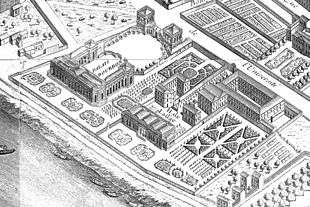Palais Bourbon

The Palais Bourbon (pronounced: [pa.lɛ buʁ.bɔ̃]) is a palace located in the 7th arrondissement of Paris, on the left bank of the Seine, across from the Place de la Concorde. It is the seat of the French National Assembly, the lower legislative chamber of the French government.
History


The palace was originally built for the legitimised daughter of Louis XIV and Françoise-Athénaïs, marquise de Montespan - Louise-Françoise de Bourbon, duchesse de Bourbon, to a design by the Italian architect Lorenzo Giardini, approved by Jules Hardouin-Mansart. Giardini oversaw the actual construction from 1722 until his death in 1724, after which Jacques Gabriel took over, assisted by L'Assurance and other designers, until its completion in 1728.
Rather than a palace, for it was not a royal seat of power, the French termed it a maison de plaisance overlooking the Seine, facing the Tuileries to the east and the developing Champs-Élysées on the west. At the start it was composed of a principal block with simple wings ending in matching pavilions. Bosquets of trees—planted in orderly rank and file—and parterres separated it from the nearby Hôtel de Lassay. In 1756 Louis XV bought it for the Crown, then sold it to the grandson of the Duchess, Louis Joseph, Prince of Condé, for whom Jacques-Germain Soufflot directed an enlargement in 1765.
During the revolution
During the French Revolution the Palais Bourbon was nationalized, and the Council of the Five Hundred met in the palace from 1798. Then, as part of Napoleon's plans for a more monumental Paris, Fontanes, the president of the Corps législatif as it was now called, commissioned the magnificent pedimented portico by architect Bernard Poyet, added to the front of the Palais that faces the Place de la Concorde from the south. It mirrors the similar classicizing portico of the Madeleine, visible at the far end of the rue Royale.
Bourbon Restoration
In a symptom of the political tone of the Bourbon Restoration, the returning exile, the prince de Condé took possession, and rented to the Chamber of Deputies a large part of the palace. The palace was bought outright from his heir in 1827, for 5,250,000 francs.[1] The Chamber of Deputies was then able to undertake major work, better suiting the chamber, rearrangement of access corridors and adjoining rooms, installation of the library in a suitable setting, where the decoration and one of the salons were entrusted to Delacroix, later a Deputy himself. The pediment was re-sculpted by French artist Jean-Pierre Cortot.
1840s
Delacroix, with the help of some assistants, painted the entire vault of the long gallery which was to house the library. His work there was completed by the end of 1847 and immediately hailed as a masterpiece by the critic.[2]
The Chamber of Deputies elected in 1846 was abruptly disbanded by the February Revolution, which oversaw an unprecedented direct election by universal suffrage to convene a Constituent Assembly that was followed by a National Legislative Assembly in 1849. (See also French demonstration of 15 May 1848.)
Hôtel de Lassay
The adjacent Hôtel de Lassay, connected by a gallery to the Palais Bourbon, serves as the official residence of the National Assembly's president.
Library
The extensive library, originally set up from books belonging to the clergy and to aristocrats who left France during the Revolution, contains among others:
- The minutes of Joan of Arc's trial
- Jean-Jacques Rousseau's manuscripts deposited by his widow in 1794
- the Codex Borbonicus
Gallery
-

Palais Bourbon seen from the Quai des Tuileries
-
The Palais Bourbon at night
-

Library of the Palais Bourbon
-

Decoration of the salon du Roi by Eugène Delacroix
-

The hemicycle of the National Assembly
-
Page 14 of the Codex Borbonicus
See also
- List of works by James Pradier Sculpture
References
- ↑ "Assemblée nationale ~ Les députés, le vote de la loi, le Parlement français". Assemblee-nat.fr. Retrieved 2012-09-07.
- ↑ ["Delacroix's paintings for the Library of the Assemblée nationale". Assemblee-nationale.fr. Retrieved 2014-01-09.
External links
| Wikimedia Commons has media related to Palais Bourbon. |
- Palais Bourbon - a palace for democracy, Secretariat-General of the National Assembly - Communication and multimedia information department
- History of the Palais Bourbon
- Connaissance de l'Assemblée: histoire et génie des lieux (in French)
Coordinates: 48°51′43″N 2°19′07″E / 48.862036°N 2.318593°E
|